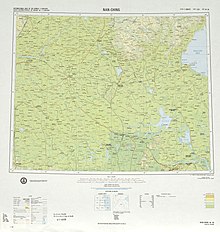K'ai-feng
Appearance
English
[edit]
Etymology
[edit]From Mandarin 開封 / 开封 (Kāifēng), Wade–Giles romanization: Kʻai¹-fêng¹.[1][2]
Proper noun
[edit]K'ai-feng
- Alternative form of Kaifeng
- [1904, C. D. Tenney, “中國 [Zhōngguó, The Chinese Empire]”, in Geography of Asia[2], New York: MacMillan and Co, →OCLC, page 10:
- The capital, Kʻai-fêng Fu (開封府), is situated a few miles from the south bank of the Yellow River.]
- 1975, John Winthrop Haeger, editor, Crisis and Prosperity in Sung China[3], Tucson, Arizona: University of Arizona Press, →ISBN, →LCCN, →OCLC, pages 61–62:
- The eastern part of the city of K'ai-feng and is adjacent rural area was under the hsien of K'ai-feng; the western part and its adjacent rural area under that of Hsiang-fu (at first called Chün-i).
- 1978, Yasushi Inoue, translated by Jean Oda Moy, Tun-huang[4], Kodansha International, →ISBN, →LCCN, →OCLC, page xi:
- The main character, Chao Hsing-te, has gone to K'ai-feng to take his Palace Examination.
- 2011, Gary Schwartz, The Impulse Economy : Understanding Mobile Shoppers and What Makes Them Buy[5], Atria Books, →ISBN, →LCCN, →OCLC, page 33:
- I was in China twenty years ago, filming a documentary on the last Chinese Jews of the old trading city K'ai-feng, located just south of Beijing.
- For more quotations using this term, see Citations:K'ai-feng.
Translations
[edit]Kaifeng — see Kaifeng
References
[edit]- ^ Kaifeng, Wade-Giles romanization K’ai-feng, in Encyclopædia Britannica
- ^ “Selected Glossary”, in The Cambridge Encyclopedia of China[1], Cambridge University Press, 1982, →ISBN, →LCCN, →OCLC, pages 476, 480: “The glossary includes a selection of names and terms from the text in the Wade-Giles transliteration, followed by Pinyin, […] K'ai-feng (Kaifeng) 開封”
Further reading
[edit]- “K'ai-feng” in TheFreeDictionary.com, Huntingdon Valley, Pa.: Farlex, Inc., 2003–2025.
